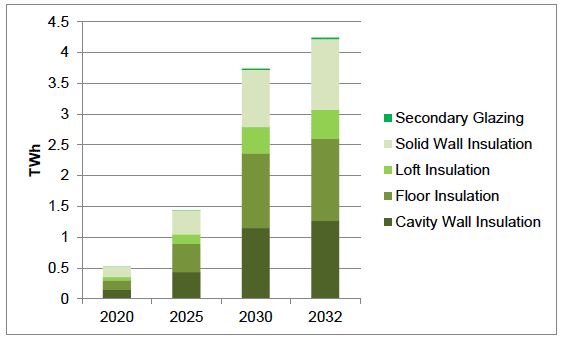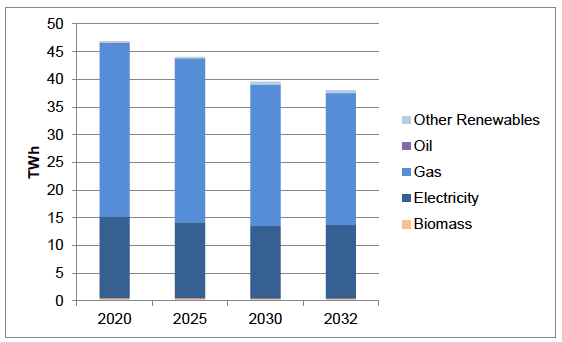Climate Change Plan: third report on proposals and policies 2018-2032 – technical annex
This annex provides an overview of the analysis underpinning the Climate Change Plan
Buildings
Residential Sector:
Sector Overview:
The Residential sector includes all energy service demands and emissions from the Scottish housing stock. Scottish TIMES splits the sector into three broad demand sub-sectors:
- Heating (space and hot water heating), using a range of fuels
- Cooking, using a range of fuels
- Appliances (lighting, refrigerators/freezers, wet appliances, consumer electronics, computers and other appliances), which consume electricity
The National Household Model ( NHM) is designed for detailed modelling of the residential sector, and it can therefore be run using all dwellings sampled by the Scottish House Condition Survey ( SHCS). Following a statistical review, the various dwellings sampled by the SHCS were aggregated into six different archetypes in TIMES, to strike a balance between computational simplicity and capturing the variability of the housing stock. These were:
- Existing urban houses
- Existing rural houses
- Existing flats
- New urban houses
- New rural houses
- New flats
Assumptions are made for each of the energy service demands in the base year for urban houses, rural houses and flats. The only demands for which a distinction is made between existing and new dwellings are the space and hot water heating demands. For all other energy service demands, dwellings of all ages are combined but the distinction between urban house/rural house/flat is maintained.
Data Inputs:
Final demands for space heat, hot water and appliances are exogenous to the model. These are determined based on average space heat and hot water demand for existing and new dwellings from the Scottish House Condition Survey; existing and projected future number of dwellings from the Transport Model for Scotland (used to derive existing and future demand for space heat, hot water and all appliances, except computers and consumer electronics); as well as number of lighting units per dwelling and growth in demand for computers and consumer electronics consistent with the UK TIMES model.
Base year average space heat and hot water demand has been calibrated to account for differences between modelled and actual data, based on data from the UK TIMES model. New build average demand is lower than for existing homes to account for tightening building standards over time, with the reduction based on data from the Scottish House Condition survey.
Technical potential and cost data for the Residential sector were originally based on UK TIMES, but subsequently the range of conservation measures, as well as their potential future energy savings and costs, were updated to be consistent with NHM outputs based on data from the Scottish House Condition Survey. Potential energy savings from smart meters were taken from the UK Government's Smart Meter Roll-Out ( GB): Cost-Benefit Analysis [7] . Smart meters are expected to allow consumers to develop more energy efficient behaviours, leading to reduced energy consumption.
Additional constraints since the Draft Plan:
In addition to updating existing model assumptions, several new constraints have been added to the model since the version underpinning the draft Climate Change Plan. These include, in addition to the Greenhouse Gas Inventory:
- Ensuring a minimum share of future non-electrical heat is supplied by biomass boilers, reflecting current activity levels
- Incorporating smart meters, as detailed above
- Ensuring the phased implementation of conservation measures is in line with expected delivery under Scotland's Energy Efficiency Programme ( SEEP), as well as updating the range of measures, their savings and costs to be in line with the NHM for Scotland, as discussed above
- Constraining the potential deployment of district heating to align with figures in the UK's National Comprehensive Assessment of District Heating and Cooling (2015) [8]
- Defining an increasing share of heat and hot water demand in the Residential sector that must be met by low-carbon technologies and fuels (including electricity) over time. The share of heat and hot water demand that must be met by low-carbon technologies and fuels in the final Plan is limited to align with the proportion of properties that are not on the gas grid and advice from the Committee on Climate Change ( CCC)
Results:
Energy efficiency saves the equivalent of around 2% of demand for space heat and hot water in 2020, rising to around 15% in 2032.
The breakdown of total space heat and hot water saved by conservation measure is given in the figure below. The figure only shows those conservation measures that have been selected by TIMES and that save at least 0.1 TWh of energy in the TIMES run underpinning the Plan. Energy savings from smart meters are additional to these savings, and are assumed to be around 2% of final space and hot water demand. Cavity wall, floor and solid wall insulation deliver similar savings, with the proportion of total energy saving delivered by each remaining fairly consistent over the lifetime of the Plan.
Figure 11: Total Saving ( TWh) by Conservation Measure in Residential Sector, TIMES model results

Total fuel use by the Residential sector falls from approximately 47 TWh in 2020 to 38 TWh in 2032. Gas continues to be the main fuel source for households over the lifetime of the Plan but declines in prevalence. The use of electricity falls from 15 TWh in 2020 to 13 TWh in 2032, as a result of energy conservation and efficiency and the use of efficient heat pumps.
Figure 12: Fuel Use Breakdown ( TWh), TIMES model results

Contact
There is a problem
Thanks for your feedback